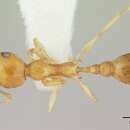mk
имиња во трошки


Taxonomy. The genus was first described by Forel (1890) as Trigonogaster , but the name was preoccupied by a pteromalid chalcid, so the new name Recurvidris was proposed by Bolton (1992). It was classified in the tribe Crematogastrini by Bolton (2003). Workers of Vietnamese species have the following features.
Worker monomorphic; head in full-face view oval or subrectangular; frontal carina and antennal scrobe absent; median portion of clypeus in lateral view relatively steeply sloping anteriad; anterior clypeal margin lacking an isolated median seta; posteromedian portion of clypeus relatively broadly inserted between frontal lobes; mandible relatively narrow; masticatory margin oblique, with 4-5 teeth; antennae 11-segmented, with distinct 3-segmented club; eye well developed, weakly pointed anteroventrally; mesosoma long; promesonotal dome raised above anterodorsal border of propodeum, with a long posterior slope to propodeum; promesonotal suture absent dorsally; metanotal groove weakly impressed dorsally; propodeal spine curving upwards and forwards from base; propodeal spiracle located close to dorsal face of propodeum, far in front of base of propodeal spine; propodeal lobe vestigial; petiole pedunculate, with a tiny to large, triangular subpetiolar process; petiolar node low and weakly conical in lateral view; postpetiole in lateral view dorsoventrally narrowed posteriorly, in dorsal view broadly attached to first gastral segment; first gastral segment behind postpetiole in lateral view extremely dorsoventrally compressed; gastral shoulder absent.
The worker of Recurvidris is somewhat similar to that of Crematogaster (Orthocrema) species (for distinguishing characters see under Crematogaster).
Vietnamese species. Three species has been found from Vietnam: glabriceps Zhou [= sp. eg-1; = sp. 6 of SKY: Eguchi et al. 2005] (Tam Dao, Van Ban); sp eg-2 (Ba Be, My Yen, Pu Mat, Van Ban); sp. eg-3 (Van Ban).
Bionomics. Vietnamese Recurvidris species inhabit forest edges and woody habitats, but rarely grasslands. They nest in the soil and build a chimney-shaped mound on the nest entrance with soil particles.
Recurvidris is a genus of ants in the subfamily Myrmicinae.[2] The genus is distributed in the Indomalayan realm, where the ants are found on the forest floor.[3]
Recurvidris is a genus of ants in the subfamily Myrmicinae. The genus is distributed in the Indomalayan realm, where the ants are found on the forest floor.
Recurvidris é um gênero de insetos, pertencente a família Formicidae.[1]
Recurvidris é um gênero de insetos, pertencente a família Formicidae.
Recurvidris (лат.) — род мелких муравьёв из подсемейства мирмицины. Эндемики Юго-Восточной Азии. Около 10 видов. Ранее, более 100 лет был известен под названием Trigonogaster[1][2].
Муравьи мелкого размера (1,5 — 3,2 мм), жёлтого цвета (исключение Recurvidris nigrans, черновато-коричневый). Усики 11-члениковые, булава 3-члениковая. Жвалы треугольные, с 4-5 зубцами. Нижнечелюстные щупики 4-члениковые, нижнегубные щупики состоят из 3 сегментов. Усиковые бороздки и лобные валики отсутствуют. Грудка тонкая и длинная. Заднегрудка с двумя длинными проподеальными шипиками, загнутыми вверх и вперёд. Стебелёк между грудкой и брюшком состоит из двух члеников: петиолюса и постпетиолюса (последний четко отделен от брюшка), жало развито, куколки голые (без кокона). Таксон был описан как Recurvidris в 1992 году английским мирмекологом Барри Болтоном (The Natural History Museum, Лондон, Великобритания) для замены преоккупированного имени Trigonogaster Forel, 1890 (за полвека до него из Франции был описан род Trigonogaster Guérin-Méneville, 1844 из семейства наездников Encyrtidae). Систематическая позиция рода Recurvidris менялась в составе подсемейства Myrmicinae от трибы Pheidologetonini (например, так считали Forel 1917, Emery 1922) до Solenopsidini (Wheeler 1922), до неясного положения incertae sedis (по взглядам Ettershank 1966, Bolton 1992), и в настоящее время до Crematogastrini (Bolton 2003)[1][3][2].
Recurvidris (лат.) — род мелких муравьёв из подсемейства мирмицины. Эндемики Юго-Восточной Азии. Около 10 видов. Ранее, более 100 лет был известен под названием Trigonogaster.